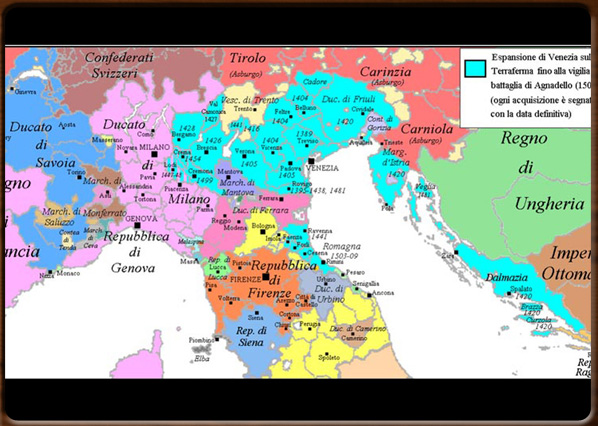
Political situation at the beginning of 16th century.

Town of Arbe, the current Rab in Croatia.

King Sigismund of Dalmatia elected emperor in 1433, Albrecht Dürer.



No video
When the old city-states began to lose the protection of Byzantium, given that they were unable to form their own defensive league due to internal disagreement, they were faced with the choice of seeking support from either Venice or Hungary .
The Dalmatians were already tied by language and culture to the Venetians and so naturally turned to Venice. The Venetian Republic granted them a lot of freedom and privileges for strategic purposes, since its main purpose was to prevent the rise of any dangerous political or commercial competitor in the Eastern Adriatic.
In exchange for this protection, the Dalmatian cities provided Venice with a contingent for the army or navy and sometimes paid a tribute in money or in kind.
The town of Arbe , for example, paid Venice an annual tribute of five kilos of silk or two of gold. Hungary, on the other hand, defeated the last king of Croatia at the end of the 9th Century and advanced claims to all the Croatian lands under the Treaty of 1102, resulting in King Coloman’s conquest of Dalmatia in 1105. This marked the start of a struggle between Hungary and Venice to conquer the smaller areas and cities and so bring them under their jurisdiction: the towns of Zara (Zadar), Spalato (Split), Trau (Trogir) and Ragusa (Dubrovnik) and the surrounding lands changed hands several times between Venice and Hungary during the 12th Century.
Half a century later, Dalmatia was hit by the Black Death, leading to such a serious economic crisis that the city became increasingly dependent on Venice. Over the space of a hundred year (1300-1400) an internal struggle between King Sigismund of Hungary and the Neapolitan house of Anjou helped weaken the Hungarian influence on Dalmatia.
The Angevins sold their rights to the Dalmatian lands to Venice for 100,000 ducats, so that the Venetians possessed most of Dalmatia in 1420. In 1437, King Sigismund put an end to the 100 years’ dispute by acknowledging that Venice had effective dominion over Dalmatia.
1100 - 1200 - - rev. 0.1.6